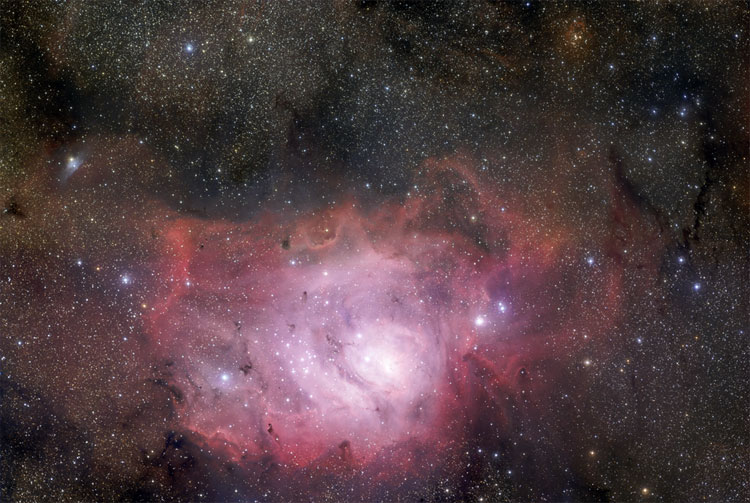 The California Nebula, or NGC 1499, an emission nebula about 1500 light years away, in the direction of Perseus. Like the Sun, the Nebula is currently traversing the Orion Arm of our galaxy. The cloud of gas is about 100 light-years in length and over 2 degrees in apparent length, despite its distance. Its reddish glow is due to the recombination of hydrogen atoms with electrons previously stripped from the atoms by ultraviolet radiation, most likely from the bright hot bluish Xi (ξ) Persei, also known as Menkib, which is just above and to the left of the Nebula in this image, and slightly behind the Nebula relative to us.
Although only a fourth magnitude star as seen from the Earth, Menkib emits over ten thousand times as much visual radiation as the Sun, and over twenty times that much ultraviolet radiation, making its total luminosity over three hundred thousand Solar luminosities. With a surface temperature of about 67,000 Fahrenheit degrees (37,000 Kelvins), the forty-Solar-mass star is among the hottest stars visible (in a dark sky) without optical aid. In this case, however, considerable optical aid was used, as the image was taken with the 48-inch Schmidt-Cassegrain at Palomar Observatory as part of the National Geographic survey of the sky, whose purpose is to compare the views taken with the first such survey, half a century ago. (Scott Kardel, Caltech, Palomar Observatory, Digitized Sky Survey,
apod060924)
M8 -- The Lagoon Nebula
An emission nebula in Sagittarius

Above: (N. A. Sharp, REU Program, AURA, NOAO, NSF, apod021006) / Below: (ESO, apod091006)
The Lagoon Nebula (M8) lies about 5000 light-years from the Earth, in the direction of the constellation of Sagittarius (and hence toward the center of our galaxy). It is best seen telescopically at very low power, as its 100 light-year span is nearly three times the half-degree diameter of the Moon. As shown by the different appearance of the images above and below its "color" depends upon the artistic whims of the the person who chooses the colors representing different wavelengths in or out of the visible spectrum. Its actual visual appearance is of a ghostly gray cloud spread across the starry background formed by stars lying between us and it, and within its star-forming regions.

|